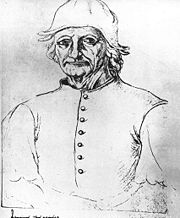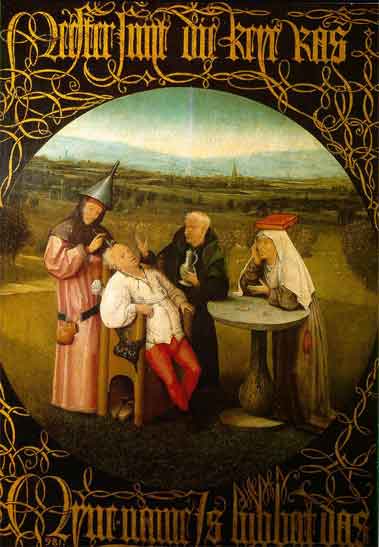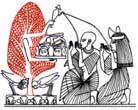لوحات مختارة
|
جيروم بوش

Jerome Bosch
|
لوحات مختارة
|
 |
C. G.
Jung described him as "The master of the monstrous... the
discoverer of the unconscious..."
Hieronymus,
or Jerome, Bosch,
b. c.1450, d. August 1516, spent his entire artistic career in the small
Dutch town of Hertogenbosch, from which he derived his name. He was also
a member of the religious Brotherhood of Our Lady, or whom he painted
several altarpieces for the Cathedral of Saint John's, Hertogenbosch,
all of which are now lost. At the time
of his death, Bosch was internationally celebrated as an eccentric
painter of religious visions who dealt in particular with the torments
of hell. During his lifetime Bosch's works were in the inventories of
noble families of the Netherlands, Austria, and Spain, and they were
imitated in a number of paintings and prints throughout the 16th
century, especially in the works of Pieter Bruegel the Elder. His style was unique, strikingly free, and
his symbolism, unforgettably vivid, remains unparalleled to this day.
Marvellous and terrifying, he expresses an intense pessimism and
reflects the anxieties of his time, one of social and political
upheaval.
From the
WebMuseum Site, Paris
|
وصفه
كارل غوستاف يونغ محقاً بـ"سيد الرهبة
... ومكتشف اللاوعي" ولد هيرونيموس،
المعروف بجيروم بوش، عام 1450 في بلدة
هورتوجينبوش الهولندية التي قضى فيها جل
حياته، وأعطته اسمها. وقد توفي فيها في شهر
آب من العام 1516. كان بوش في حياته عضواً في
جمعية "سيدتنا" الدينية التي قدم
لها ولكاتيدرائية بلدته العديد من
أعماله التي فقدت كلها. حين وفاته كان بوش
قد أصبح معروفاً على الصعيد الدولي،
كرسام غريب الأطوار وذو رؤى دينية تتطرق
بشكل خاص إلى العذابات الجهنمية. أقتنت
أعماله العائلات النبيلة في هولندا
والنمسا وإسبانيا. وقلده الكثيرون في
القرن السادس عشر، وعلى رأسهم بيوتر
بروغل الكبير الذي تأثر جداً به. فأسلوبه
المتميز الفاقع من حيث الحرية وذو الرمزية الجلية، ما زال لا يضاها حتى
يومنا. حيث عبر بشكل رائع ومخيف عن تشاؤم
كبير عكس مخاوف ذلك الزمان ما تمخض عنه من
نهوض اجتماعي وسياسي.
|
 |
The Extraction of the Stone of Madness (The Cure of Folly)
c. 1475-80; Oil on board, 48 x 35 cm (18 7/8 x 13 3/4");
Museo del Prado, Madrid
Removing "stones" from the head was a fairly common medieval
operation; however, for some reason Bosch has painted a flower as the
object being removed.
|
إستخراج
حجر الجنون أو معالجة الجنون
– ما بين 1475 و 1485 رسم زيتي على لوح خشبي، 48
*35 سم. في متحف البرادو في مدريد.
لقد
كان استخراج الحجر من الرأس ممارسة عملية
شائعة في العصر الوسيط. لكن، لأسباب
تخصه، رسم بوش وردة ليمثل الجسم المستخرج.
|
 |
| |
|
 |
Front Page
|
|
Spiritual Traditions
|
Mythology
|
Perennial Ethics
|
Spotlights
|
Epistemology
|
Alternative Medicine
|
Deep Ecology
|
Depth Psychology
|
Nonviolence &
Resistance
|
Literature
|
Books & Readings
|
Art
|
On the Lookout
|

|
|